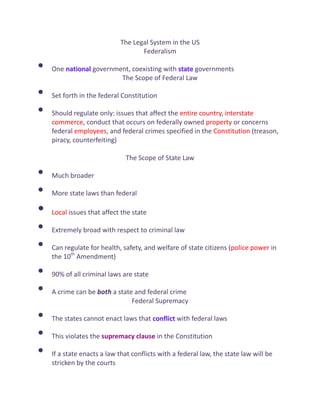
Chapter 2
- 1. The Legal System in the US Federalism • One nnaattiioonnaall government, coexisting with ssttaattee governments The Scope of Federal Law • Set forth in the federal Constitution • Should regulate only: issues that affect the entire country, interstate commerce, conduct that occurs on federally owned property or concerns federal employees, and federal crimes specified in the Constitution (treason, piracy, counterfeiting) The Scope of State Law • Much broader • More state laws than federal • Local issues that affect the state • Extremely broad with respect to criminal law • Can regulate for health, safety, and welfare of state citizens (police power in the 10th Amendment) • 90% of all criminal laws are state • A crime can be both a state and federal crime Federal Supremacy • The states cannot enact laws that ccoonnfflliicctt with federal laws • This violates the supremacy clause in the Constitution • If a state enacts a law that conflicts with a federal law, the state law will be stricken by the courts
- 2. • States can never enact laws that conflict with the Constitution (nor can the federal government) Branches of Government • Set forth in the Constitution • The Constitution describes the federal government, but states generally mirror the branches of government at the state level • Legislative, executive, judicial Legislative Branch • Federal-called Congress • Senate and house of representatives • Duty is to create statutory laws • At the state level is called state legislature Executive Branch • At the federal level, president and all federal law enforcement • Duty is to enforce the laws passed by the legislative branch • At the state level, ggoovveerrnnoorr and all state law enforcement Judicial Branch • At the federal level, headed by the US Supreme Court; includes all federal courts • Duty is to interpret the laws passed by the legislative branch and the Constitution • At the state level, headed by the state’s highest court; includes all state courts •• Very powerful branch because of jjuuddiicciiaall rreevviieeww
- 3. Separation of Powers • Each branch must stay within its designated role • If a branch tries to act outside its role, the courts can declare that it is violating separation of powers • Each branch checks and balances (keeps an eye on) every other branch • Prevents power from being centralized The Court System • There are two: federal and state • Each court must have jurisdiction, or authority, to hear a matter before it. • Original jurisdiction: the power to hear a trial and accept evidence • Appellate jurisdiction: the power to review a trial, and reverse (change the decision) affirm (uphold the decision) or remand (send the matter back to the trial court) Federal Court System • Trial court: District Court • First level of appeal: US Court of Appeal (Circuit Court) • Highest court: US Supreme Court • Federal courts can only hear federal matters, unless citizens from different states are suing each other civilly for $75,000 (diversity jurisdiction) State Court System • Small claims court: civil court with a limit on damages • Trial court: often called superior or county court
- 4. • First level of appeal: court of appeals • Second level of appeal (some states): supreme court • Cases can go from the state high court to the US Supreme Court if they have a federal matter (federal statute or federal Constitution). Must petition for a writ of certiorari Burden of Proof • The obligation to prove a disputed allegation, charge, or defense • Has two components: burden of production and burden of persuasion • Production: must produce evidence • Persuasion: must persuade the trier of fact (decision maker at trial-either a judge or jury) to a certain standard Burden of Proof in a Criminal Prosecution: • For the prosecution: beyond a reasonable doubt, which is the most difficult standard • For the defense: to prove an affirmative defense, the defendant must either produce evidence, then the prosecution disproves the defense beyond a reasonable doubt or preponderance of evidence, or prove the affirmative defense to a preponderance of evidence • Preponderance of evidence: more likely than not, 51% to 49%-much lower standard than beyond a reasonable doubt Burden of Proof in a Civil Litigation Matter • Preponderance of evidence for both the plaintiff and the defense Inference and Presumption • Help meet the burden of proof • Inference: a conclusion the trier of fact can choose to make
- 5. • Presumption: a conclusion the trier of fact must make. Presumptions can be overcome by evidence disproving them (rebuttable) or can be irrefutable (irrebuttable) • Inferences and presumptions are included in jury instructions Circumstantial and Direct Evidence • Circumstantial: indirectly proves a fact. Blood evidence, fingerprints, DNA • Direct: directly proves a fact. Confession, video, witness testimony • Although circumstantial evidence is indirect, and therefore leaves room for reasonable doubt, it can be compelling and is not necessarily inferior to direct evidence. Criminal cases can be successfully prosecuted with circumstantial evidence, standing alone
